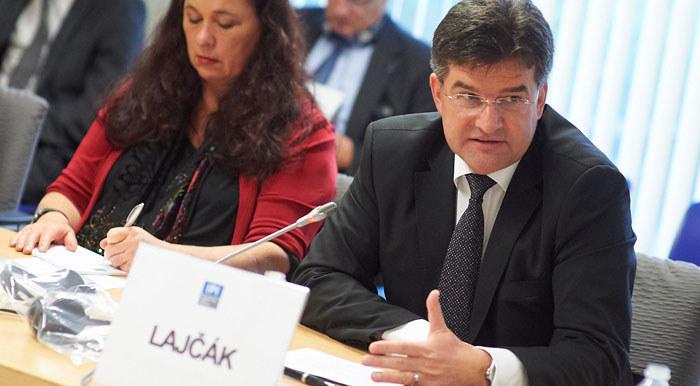
On October 4th, IPI organized a workshop in Brussels to look at new approaches to the Transdniestrian settlement process.
As part of IPI’s “Breaking the Ice” project which is looking at new approaches to the so-called “frozen” conflicts in the OSCE area, and in support of Ukraine’s Chairmanship of the OSCE, the IPI-facilitated meeting brought together the mediators of the “5+2” process (including Moldovan Deputy Prime Minister Eugen Carpov and the chief negotiator for Transdniestria, Nina Shtanski) with international experts to take a fresh look at resolving this protracted conflict.
In the past twenty years (since a cease-fire was signed in July 1992), several attempts have been made to reach a negotiated political settlement between Moldova and the break-away region of Transdniestria. Yet the two sides remain divided, to the detriment of communities on both sides of the Dniestr river. As the keynote speaker at the meeting, Slovak Foreign Minister Miroslav Lajcak, remarked: “No solution cannot be a solution for ever.”
The main negotiating framework is the “5+2” process comprised of Moldova, Transdniestria, the Organization for Security and Cooperation in Europe (OSCE), the Russian Federation, and Ukraine plus the European Union and the United States. Recent discussions have mostly focused on socio-economic issues as well as general legal and humanitarian issues and human rights. In the past few years, there has been little discussion of the bigger issue of a comprehensive settlement, including institutional, political and security issues.
The IPI workshop (which took place at the Mission of Switzerland to the European Union) provided an opportunity to recall past settlement proposals (like CSCE Mission report 13 of 1993, the Moscow Memorandum of 1997 as well as the Mediators’ Document and the Kozak Memorandum of 2003), reviewed the current situation, and looked at settlement processes in other parts of the world which could offer inspiration to the two sides. Current attempts to resolve the conflict were also put into the context of EU-Russia relations since Russia is seeking to attract former Soviet republics, like Moldova, to join the recently established Eurasian Union while Moldova is trying to move closer to the European Union, for example by signing a Deep and Comprehensive Free Trade Agreement.
Particular emphasis was put on the potential economic benefits that a settlement could have for both parties, as well as the harm that the current impasse is having. For example, both sides could benefit by improving freedom of movement and infrastructure since Chisinau and Tiraspol are along north-south and east-west trade routes and transportation corridors. But as a result of two decades of deadlock and the continued closure of a major bridge across the Dniestr, the economies of both sides are suffering (except for a few members of the elite who profit from the status quo). As one participant remarked, “the globalizing world is leaving both sides behind”.
Suggestions were therefore made on how to break the ice, and make a fresh attempt to reach a mutually agreeable solution.
IPI remains committed to promoting confidence-building measures across the Dniestr, and to working with the parties, in support of the Chairmanships of the OSCE (Ukraine in 2013, Switzerland in 2014 and Serbia in 2015), to facilitate track II diplomacy and to provide expert advice that could contribute to settlement of the conflict.







